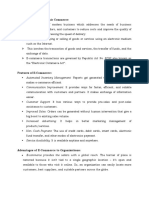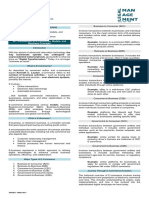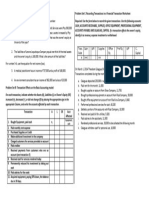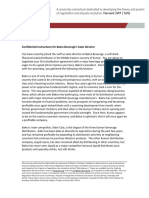Building Blocks of E-Commerce
E-commerce is built on several foundational elements that enable it to function effectively. Here
are the key building blocks:
1. Website and User Interface
E-Commerce Platform: Software solutions (e.g., Shopify, Magento) that allow
businesses to create online stores.
User Experience (UX): Design principles that ensure easy navigation, appealing layout,
and an intuitive shopping experience.
2. Product Information Management
Catalog Management: Organizing product data, including descriptions, images, prices,
and availability.
Search Functionality: Implementing effective search and filtering options to help
customers find products easily.
3. Payment Processing
Payment Gateways: Services (e.g., PayPal, Stripe) that facilitate secure online
payments.
Multiple Payment Options: Offering various methods (credit cards, digital wallets,
cryptocurrency) to cater to customer preferences.
4. Logistics and Supply Chain Management
Inventory Management: Tracking stock levels, managing suppliers, and ensuring
product availability.
Shipping Solutions: Coordinating delivery options, handling returns, and providing real-
time tracking for customers.
5. Marketing and Sales Strategy
Digital Marketing: Utilizing SEO, social media, email marketing, and content marketing
to drive traffic and sales.
Customer Relationship Management (CRM): Tools for managing customer
interactions and data to improve engagement and retention.
6. Security and Compliance
Data Security: Protecting customer data through encryption and secure payment
processing.
Compliance: Adhering to regulations such as GDPR, PCI-DSS, and other relevant laws
governing online transactions.
�7. Customer Support
Multichannel Support: Providing assistance through various channels (chat, email,
phone).
Feedback Mechanisms: Collecting and responding to customer reviews and inquiries to
enhance service quality.
8. Analytics and Reporting
Data Analysis: Monitoring website traffic, sales performance, and customer behavior to
make informed decisions.
KPIs and Metrics: Identifying key performance indicators (e.g., conversion rates,
average order value) to assess success.
RoadMap of e-Commerce in India
Here is a brief roadmap of the development of e-commerce in India:
Early beginnings: The first e-commerce website in India, Fabmart, was launched in 1999, offering online
grocery shopping. However, it was not until the mid-2000s that e-commerce began to gain traction in
India.
The emergence of Flipkart: Flipkart, an online bookstore launched in 2007, quickly expanded to become
one of India’s largest e-commerce companies. It paved the way for other online marketplaces to enter
the market.
Growth of mobile commerce: The widespread adoption of smartphones in India has led to a significant
increase in mobile commerce. In 2016, mobile commerce accounted for over 50% of all e-commerce
transactions in India.
Emergence of Amazon and Alibaba: Global e-commerce giants such as Amazon and Alibaba have
entered the Indian market in recent years, increasing competition and driving innovation.
Government initiatives: The Indian government has launched several initiatives to promote e-commerce
in the country, including the Digital India campaign and the Startup India program.
Growth of niche e-commerce: In addition to large online marketplaces, niche e-commerce sites have
also emerged in India, catering to specific markets such as fashion, beauty, and home goods.
Future developments: E-commerce in India is expected to continue to grow rapidly in the coming years,
driven by increasing internet penetration, rising consumer incomes, and the government’s push for
digitalization.
E-business models can be classified based on the relationship between transaction parties. Here are
some examples:
�Business-to-Business (B2B): In a B2B model, businesses sell products or services to other businesses. This
model is typically used for selling goods in large quantities or for specialized products or services that
are needed by other businesses.
Business-to-Consumer (B2C): In a B2C model, businesses sell products or services directly to individual
consumers. This model is commonly used in retail and e-commerce settings, where businesses sell
products or services to a large number of individual customers.
Consumer-to-Consumer (C2C): In a C2C model, consumers sell products or services directly to other
consumers. This model is commonly used in online marketplaces such as eBay or Craigslist, where
individuals can buy and sell goods or services to one another.
Consumer-to-Business (C2B): In a C2B model, consumers offer products or services to businesses. This
model is commonly used in freelance or consulting industries, where individuals offer their services to
businesses or corporations.
Business-to-Government (B2G): In a B2G model, businesses sell products or services to government
agencies. This model is commonly used for selling specialized goods or services that are needed by
government agencies or for government contracts.
Government-to-Business (G2B): In a G2B model, government agencies offer goods or services to
businesses. This model is commonly used for procurement processes, where government agencies offer
contracts to businesses that can provide the necessary goods or services.
E-Commerce Sales Life Cycle (ESLC) Model
The E-Commerce Sales Life Cycle (ESLC) model is a framework that describes the various stages of a
typical e-commerce sales process. Here are the different stages of the ESLC model:
Awareness: This is the first stage of the sales life cycle, where customers become aware of the product
or service being offered. This stage typically involves marketing and advertising efforts such as search
engine optimization (SEO), social media marketing, and pay-per-click (PPC) advertising.
Interest: In this stage, customers have expressed some level of interest in the product or service being
offered. This may involve visiting the website, subscribing to a newsletter, or following the brand on
social media.
Consideration: During the consideration stage, customers are actively researching and evaluating the
product or service. They may read reviews, compare prices, and seek out additional information about
the product or service.
�Purchase: This is the stage where customers make the decision to purchase the product or service. This
may involve adding the item to a cart, entering payment information, and completing the transaction.
Post-Purchase: The post-purchase stage is crucial for building customer loyalty and generating repeat
business. This stage involves providing customer support, offering incentives for future purchases, and
soliciting feedback and reviews.
Advocacy: The final stage of the ESLC model involves turning satisfied customers into brand advocates.
This may involve encouraging customers to share their positive experiences on social media, offering
referral bonuses, and providing opportunities for customers to provide testimonials or case studies.
By understanding the different stages of the e-commerce sales life cycle, businesses can develop
strategies to effectively engage with customers and drive sales.






















































































